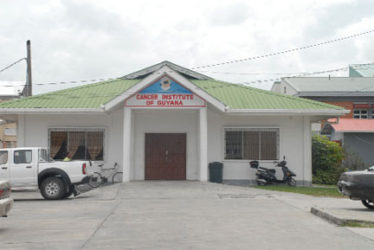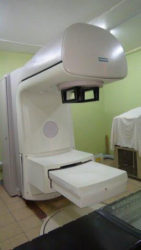For most people with cancer, living with the disease is the biggest challenge they have ever faced. Not only are their lives drastically changed, but those of their loved ones as well.

In Guyana, it is no different. For patients diagnosed with the disease, finding hope and courage in the wake of a devastating diagnosis may seem like a daunting task.
However, for the past ten years, there has been an institution providing not only treatment for various types of cancer but also support for those living with it. Located in the compound of the Georgetown Public Hospital, the Cancer Institute of Guyana, which is the only one of its kind here, has made significant contributions in the health sector.
The institute opened its doors on June 6, 2006 and was birthed via a collaborative effort between the Government of Guyana through the then Ministry of Health, and the private sector in the form of Global Imaging Services Incorporated. Among the services on offer are CT scans, pap smears, chemotherapy, mammograms, external radiation therapy, intracavitary therapy and medical consultations.

“Founder of the Institute, George Nella, he came here and saw the situation here; that cancer patients don’t have any facilities where they can be treated and diagnosed, especially the fact that radiation therapy was not here. There was no CT scan,” Dr Syed Ghazi, Sonologist, Internist and Director of Outreach at the institute recalled in a recent interview with Stabroek News.
“What he [Dr Nella] did, is he went back and he started working… Then we had this facility, the Cancer Institute, where we acquired a CT scan and radiation therapy equipment,” he said.
According to Dr Ghazi, when it was observed that patients were coming to the facility when the disease was already advanced, they saw the need to not only diagnose but also start screening.
“We needed to address that issue of a centre which could not only diagnose them but start the screening so we started as a centre for receiving these patients sent by doctors or they come themselves to see what kind of cancer they have so that we could screen them using

our facility,” he said. While the facility does not boast a large complement of doctors “we have people with good minds, expert physicians,” he said.
Dr Ghazi added too that several patients from other Caribbean countries also come to the institute to get treatment.
Over the past decade, like any institution, while boasting of a plethora of achievements, there have also been challenges. “…Lots of challenges…what we would like is for more persons to become involved with the institution, especially the people who are settled here. They have to come and join hands with us in fighting this monster,” Dr Ghazi said.
He disclosed that since the facility is not government-owned, they do not receive money from the public coffers. “We don’t get money from the government. We cannot charge patients like how they are charged in America. We know the resources of the people [but] at the end of the day we are always short of funds. We have a foundation here where we try to help them as much as possible but again the foundation is not of [a] million dollars. We try to help but we need people to join us in this fight,” he emphasised.
He said that the foundation supports the institute. “If the patient does not have money we don’t let them go. We try to raise money for them and help them to get diagnosis because diagnosis is important. We can’t let anybody go who is coming from Pomeroon or… Region One or Region Two. We try to help them.
“The main purpose of Cancer Institute is to help the people. We are not here to make money but of course we are a facility and we have to charge. If we don’t charge, we can’t maintain the facility,” Dr Ghazi said.
He added that there is good cooperation from government and some who are directed there from the public health system have their costs subsidised.
Stabroek News was also able to speak to Chief Radiation Oncologist Dr Sayan Chakraborty who recently joined the institution. At present, Dr Chakraborty is spearheading the transition of radiation treatment “in a way that we are going in a next stage of our plan,” Dr Ghazi said.
Dr Chakraborty explained that at present, the institute is days away from acquiring a machine to further the battle against cancer. “We are bringing in a machine – Brachytherapy machine – that can give radiation from external source, away from the body… This is a state-of-the-art machine and any developed oncology centre in the world would have this machine,” he said.
Brachytherapy involves placing a radioactive material directly inside or next to the tumour. This allows a physician to use a higher total dose of radiation to treat a smaller area and in a shorter time than is possible with external beam radiation treatment. There is minimal impact on surrounding tissues. The use of the brachytherapy machine has proven to be a successful treatment for cancers of the prostate, cervix and breast as well as soft tissue sarcomas and other types of cancer.
“The essence of this machine is that it radiates through the tumour only without harming the surrounding normal tissues. So, in that way we can deliver a very high dose [of radiation] to the tumour but [it] does not cause so much side effects. So we can look at a very high tumour kill but without substantial normal tissue side effect,” Dr Chakraborty explained.
He said that on the acquisition of the machine, treatments will start by the end of July. He highlighted that the machine is the first of its kind here. “This is one of the first in Guyana. Guyana has never seen other radiation machines like this…There are some Caribbean islands which still do not have this type of machine,” he said.
“When this machine actually comes, we can even avoid surgery as a treatment for some of the cancers so those people who cannot take surgery due to age or any other medical factor…can be treated with this radiation machine without the need for surgery,” Dr Chakraborty added.
Screened
In relation to prostate cancer, the oncologist recommended that men with a strong family history of the disease get screened at age 40. “Otherwise, men 45 and above should get yearly tests. He said, “One is called a PSA – Prostate Specific Antigen – which is a blood test and the other is the DRE – Digital Rectal Examination. Combination of the two is very sensitive in diagnosing the cancer. DRE is very much dependent on the experience of the doctor,” he explained.
As it relates to breast cancer which is seen as the most common type of cancer in Guyana, Dr Chakraborty said they have found a lot of younger women showing up at the institution with this cancer. In terms of cervical cancer, seen as the second most common cancer in Guyana, he said while this type of cancer is usually a disease of the elderly portion of the female population, “there is a particular virus, the Human Papillomavirus which is actually responsible for the survival of cancer in young women as well… We have seen cervical cancer in women as young as 17 and 18,” he disclosed. Cervical cancer occurs in the cervix and it is due to the abnormal growth of cells.
Dr Ghazi told this newspaper that currently, the Cancer Institute is partnering with the Caribbean Coalition against Cervical Cancer to eliminate cervical cancer by the year 2025.
Dr Ghazi, who is also the Outreach Director for the facility said that they have been doing a significant amount of work in Guyana’s hinterland regions. “We went to Mabaruma, to Moruca. This is a campaign we are doing through an Australian grant. What we do is we take our team to different remote regions. We do pap smear, screenings for cervical cancer,” he said.
The director pointed out that during these many outreaches, they found that cervical cancer is common in Guyana’s indigenous population. “The risk factors are very high. Multiple sex partners, multiple pregnancies. These campaigns are done several times a year. We are trying to fight these monsters [cancers] with a team of specialists here. We saw more than 200 patients in last week’s outreach,” he added.
Dr Ghazi disclosed that since the establishment of the Institute, they have diagnosed more than 2,000 patients and provided chemotherapy to approximately 100 with 1,500 patients receiving radiation therapy.
It is often said that early detection is key since early diagnosis allows for treatment to be more effective. To this end, Dr Ghazi said an increase in public awareness has seen persons going to the institution at an earlier stage. “Before we used to see patients coming in at later stages. Now because of outreaches…we see less in those advanced stages and more in earlier stages,” he related.
According to Dr Chakraborty, the most common types of cancer found in Guyana such as cervical, prostate and breast cancer are all very treatable and curable if detected early.
The Chief Oncologist also said that there are many patients who have a fear of biopsies and thus the institution is providing needle biopsies. A biopsy is a medical test commonly performed by a surgeon or interventional radiologist which involves the extraction of sample tissues or cells for examination to determine the presence or extent of a disease.
“Many persons have a fear of biopsies that the doctor is going to cut us, knife us, put us in the hospital for five days but nowadays we don’t do biopsies like that. We are doing needle biopsies…we are just putting a needle into the tissue, into the mass and taking out some tissue. This is plain…procedure. It does not need any general anaesthesia or knocking out the patient. The patient is conscious. The skin is only numbed. The patient can leave within 15 minutes and go home after completion of the procedure,” he said.
Both doctors also echoed the need for the efforts in fighting cancer to be more consistent. According to Dr Chakraborty, “all the efforts are more phasic…well this is Breast Cancer Month and we all go ahead and we do our walk but it is really phasic. After the Breast Cancer Month what happens then. It phases away. We need a more consistent effort and consistent involvement. These phasic involvements will not help in the long run.
“I don’t want 5,000 patients in one month. Rather, I would want 1,000 patients every month for 12 months,” he added.
Dr Ghazi said, “Every year we have the breast cancer marches but whole year I wish to see people come here and ask me if we need any help.”





